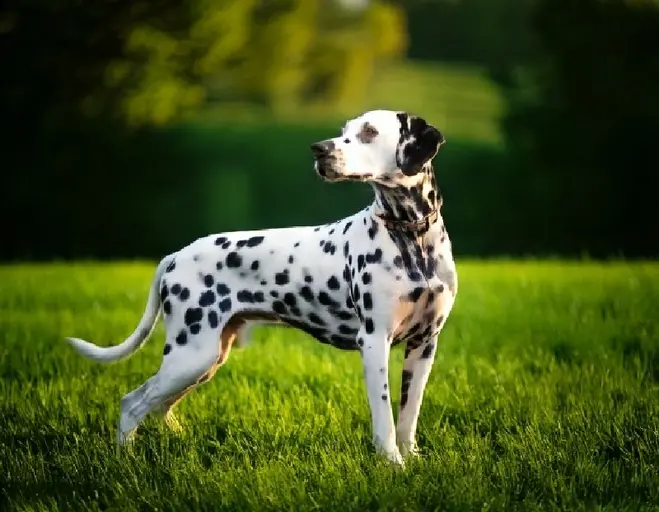The Dalmatian: A Comprehensive Guide to This Spotted Companion

Brief Introduction
The Dalmatian, instantly recognizable by its distinctive spotted coat, is a breed that combines elegance, athleticism, and a playful spirit. Not just a pretty face, the Dalmatian boasts a rich history and a unique personality that makes it a beloved companion for the right owner. They are known for their remarkable stamina and loyalty, making them excellent partners for active individuals and families. This guide aims to provide you with all the essential information you need to understand and care for a Dalmatian.
Breed History
The exact origins of the Dalmatian remain somewhat shrouded in mystery, but evidence suggests that the breed has existed for centuries.
Early Origins
While the precise birthplace is debated, many believe that the Dalmatian originated in the Dalmatia region of Croatia, hence the name. Images resembling spotted dogs have been found in ancient Greek, Egyptian, and Roman artifacts, indicating a long history. These dogs were likely used for various purposes, including guarding, hunting, and as companions.
Evolution of the Breed
Over time, the Dalmatian’s role evolved. In the 18th and 19th centuries, they became popular as coach dogs, running alongside carriages to protect the horses and clear the way. Their affinity for horses made them invaluable to travelers. They also served as firehouse dogs, running alongside horse-drawn fire engines and acting as mascots, a tradition that continues in some fire departments to this day. The breed’s versatility and adaptability contributed to its widespread popularity across Europe and eventually, the United States.
Modern Dalmatian
The Dalmatian’s popularity reached new heights with the release of Disney’s “101 Dalmatians.” While this exposure brought joy to many, it also led to irresponsible breeding and impulse purchases, resulting in many Dalmatians ending up in shelters. Responsible breeders are now dedicated to preserving the breed’s health and temperament, ensuring that the Dalmatian continues to thrive as a cherished companion.
Appearance
The Dalmatian’s appearance is one of its most defining characteristics. They are medium-sized dogs with a well-proportioned build.
Size and Build
- Height: Males typically stand between 21-24 inches (53-61 cm) at the shoulder, while females are slightly smaller, ranging from 19-22 inches (48-56 cm).
- Weight: A healthy Dalmatian usually weighs between 45-70 pounds (20-32 kg).
- Build: They have a muscular and athletic build, reflecting their history as working dogs. Their body is typically longer than it is tall, giving them a graceful and agile appearance.
Coat and Markings
- Coat: The Dalmatian’s coat is short, dense, and fine. It is known for its sleek and glossy appearance.
- Markings: The breed’s most distinguishable feature is, of course, its unique spotted pattern. The spots are ideally well-defined and evenly distributed across the body. The base color is typically white, with spots that can be black or liver (brown).
- Spot Size: Spot size varies, but generally, they are round and range from the size of a dime to a half-dollar. Spots on the head and extremities are usually smaller than those on the body.
Head and Facial Features
- Head: The Dalmatian has a moderately long head that is in proportion to its body.
- Ears: Their ears are medium-sized, set high on the head, and taper to a rounded point. They are carried close to the head.
- Eyes: The eyes are round, moderately sized, and typically brown or blue, depending on the dog’s coat color. Black-spotted Dalmatians usually have brown eyes, while liver-spotted Dalmatians may have amber or brown eyes. Some Dalmatians can have one blue eye and one brown eye.
- Tail: The tail is moderately long, reaching to the hock. It is carried slightly upward with a gentle curve.
Character and Behavior
Understanding the Dalmatian’s temperament is crucial before bringing one into your home. They are intelligent, energetic, and affectionate dogs, but they also have specific needs that must be met.
Temperament and Personality
- Affectionate: Dalmatians are known for their affectionate nature and form strong bonds with their families. They enjoy being involved in family activities and thrive on attention.
- Intelligent: They are intelligent dogs and capable of learning a wide range of commands and tricks. However, their intelligence can also make them independent thinkers, requiring a firm and consistent approach to training.
- Energetic: Bred for endurance, Dalmatians have a high energy level and require plenty of exercise. They are not suitable for sedentary owners.
- Playful: They retain a playful spirit well into adulthood and enjoy games and interactive activities.
Attitude Towards People
- Adults: Dalmatians are generally friendly and outgoing towards people they know. Early socialization is crucial to ensure they are comfortable around strangers.
- Children: They can be good with children, especially when raised with them. However, their high energy levels may make them better suited for older children who can handle their exuberance. Supervision is always recommended when Dalmatians are around young children.
Interaction with Other Animals
- Dogs: Dalmatians can be dog-aggressive, especially towards dogs of the same sex. Early socialization and training are essential to prevent aggression.
- Cats and Other Animals: With proper socialization, Dalmatians can learn to coexist with cats and other household pets. However, their strong prey drive may make it challenging to integrate them into a household with small animals like rabbits or rodents.
Trainability
- Intelligence and Independence: Dalmatians are intelligent but can also be independent, making training a challenge for some owners.
- Positive Reinforcement: Positive reinforcement methods, such as treats and praise, are most effective for training Dalmatians.
- Consistency: Consistency is key when training a Dalmatian. They need clear rules and boundaries to understand what is expected of them.
- Early Socialization: Early socialization is crucial for Dalmatians to develop into well-adjusted and confident adults. Expose them to a variety of people, places, and situations from a young age.

Care and Maintenance
Caring for a Dalmatian involves more than just admiring their spots. They have specific needs when it comes to grooming, exercise, diet, and health.
Grooming Needs
- Shedding: Dalmatians are moderate shedders, shedding year-round. Regular brushing can help to minimize shedding and keep their coat healthy.
- Brushing: Brush your Dalmatian several times a week with a rubber brush or grooming mitt to remove loose hair.
- Bathing: Bathing is only necessary when they are dirty or have a noticeable odor. Over-bathing can strip their coat of its natural oils, leading to dryness and irritation.
- Nail Care: Trim their nails regularly to prevent overgrowth, which can be painful and uncomfortable.
- Ear Cleaning: Check their ears regularly for signs of infection and clean them as needed with a veterinarian-approved ear cleaner.
Exercise Requirements
- High Energy: Dalmatians are high-energy dogs that require a significant amount of exercise to stay healthy and happy.
- Daily Exercise: Aim for at least one to two hours of exercise per day, which can include brisk walks, runs, hikes, or games of fetch.
- Mental Stimulation: In addition to physical exercise, Dalmatians also need mental stimulation to prevent boredom and destructive behaviors. Provide them with puzzle toys, training sessions, or interactive games.
Feeding Guidelines
- High-Quality Food: Feed your Dalmatian a high-quality dog food that is formulated for their age, size, and activity level.
- Portion Control: Measure their food carefully and avoid overfeeding, as Dalmatians are prone to weight gain.
- Urinary Health: Dalmatians are predisposed to forming urate stones. A low-purine diet may be recommended by your veterinarian to help prevent this condition.
Potential Health Problems
- Deafness: Congenital deafness is a common issue in Dalmatians, affecting approximately 8% of puppies. Responsible breeders screen their dogs for deafness before breeding.
- Urate Stones: Dalmatians are prone to forming urate stones in their urinary tract. A special diet and medication may be necessary to manage this condition.
- Hip Dysplasia: Hip dysplasia is a genetic condition that can lead to arthritis and mobility problems.
- Allergies: Some Dalmatians are prone to allergies, which can manifest as skin problems or digestive issues.
- Bloat (Gastric Dilatation-Volvulus): Like many deep-chested breeds, Dalmatians are susceptible to bloat, a life-threatening condition in which the stomach twists on itself.
Breed Weaknesses
While Dalmatians possess many admirable qualities, they also have certain weaknesses that potential owners should be aware of.
Potential for Aggression
- Dog Aggression: Dalmatians can be dog-aggressive, especially towards dogs of the same sex. Early socialization and training are crucial to mitigate this tendency.
- Guarding Instincts: They may exhibit guarding behaviors towards their family and territory, which can lead to aggression towards strangers if not properly managed.
Independence and Stubbornness
- Training Challenges: Their intelligence and independence can make training a challenge for some owners.
- Consistency Required: Consistency and patience are essential when training a Dalmatian.
Health Concerns
- Predisposition to Health Issues: The breed’s predisposition to certain health issues, such as deafness and urate stones, can be a concern for owners.
- Veterinary Care: Regular veterinary care and a specialized diet may be necessary to manage these conditions.
Conclusion
The Dalmatian is a magnificent breed with a rich history and a unique personality. They are loyal, affectionate, and energetic dogs that can make wonderful companions for the right owner. However, they are not the right choice for everyone. Their high energy levels, potential for aggression, and predisposition to certain health issues require a dedicated and knowledgeable owner who is willing to invest the time, effort, and resources necessary to meet their needs.This breed is suitable for:
- Active individuals and families who can provide plenty of exercise and mental stimulation.
- Experienced dog owners who are familiar with the breed’s specific needs and challenges.
- Owners who are willing to invest in training and socialization from a young age.
- Families with older children who can handle the Dalmatian’s exuberance.
- Owners who are prepared to provide regular veterinary care and a specialized diet if necessary.
If you are considering adding a Dalmatian to your family, be sure to do your research, find a reputable breeder, and be prepared to provide them with a loving and supportive home for life.

